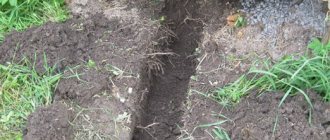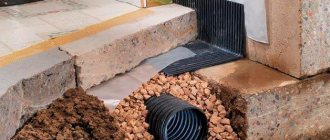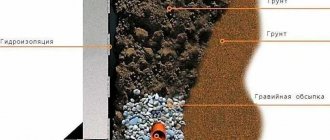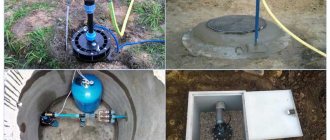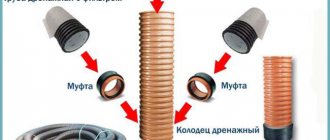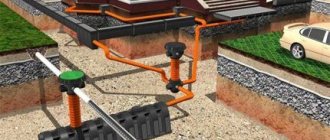Crushed stone is an important element of the drainage system. It filters dirt, prevents soil shrinkage and pipe destruction. When choosing a material, you should focus on its size, strength, and resistance to various environmental factors. Cost plays an important role.
From the Soil Trucks company you can buy crushed stone for drainage with delivery to your site at the lowest price.
Price for crushed stone for drainage from 490 rubles. for 1m3 Order
The role of the drainage layer
The main function of drainage is to remove excess water from the site. Moisture can accumulate after rains and melting snow or come up from below due to the high location of the underground aquifer.
If properly equipped with a drainage layer, it will prevent:
- Waterlogging of the area
- Pollution
- Destruction of foundations
- Flooding of basements and ground floors
- Deformation of the area
- Cracks in walkways, beds, flower beds
- Washing away fertile soil
- Rotting of plant roots
Next we will briefly explain how the drainage layer copes with each function.
Waterlogging of the area
This phenomenon is typical for areas with heavy clay or peaty soils and high groundwater levels. Waterlogging more often occurs in areas located in lowlands. After heavy rainfall and melting snow, the liquid is poorly filtered. During the same period, the aquifer rises.
The main signs of waterlogging are abundant growth of moss, reeds, cranberries, and long standing water after rain. Fruit trees, bushes and vegetables grow poorly in such areas and dry out quickly. Even the flowers in the flower beds and lawn grass are not doing well. The drainage layer helps remove excess moisture and lower its level in the soil. It is advisable to install two systems in such an area - on the surface (for precipitation) and in depth (for groundwater).
Pollution
Crushed stone in the drainage system helps combat pollution. Particles of earth, sand, clay are retained on the rough surface of stones. As a result, only clean water enters the pipe. In this case, there is no need to clean the pipes too often.
Destruction of foundations
If the soil under the foundations is constantly washed away by water, it subsides. Buildings become warped and cracks appear on the walls. With high humidity, the foundation may become covered with fungus.
The easiest way to protect the base is to add a drainage layer of crushed stone. It will quickly pass water during precipitation and strengthen the soil. If the aquifer in the area is located high, this drainage method will not be suitable. Along the perimeter, pipes should be laid on a crushed stone-sand cushion. They will drain moisture into a drainage well or ditch.
Flooding of basements and ground floors
After rains and melting snow, the groundwater level can rise sharply. Basements and ground floors are flooded if the house is built on clay, loam or peat. To prevent this from happening, a drainage system (preferably with pipes) should be laid before construction begins.
Site deformation
With increased humidity, soil swelling occurs. It worsens in winter when water freezes and expands. In spring, the entire territory of the site is covered with holes and hummocks. After heavy rains, when there are puddles in the yard, the earth can become compacted, sag, and partially erode. This also contributes to deformities.
To avoid such a negative phenomenon, it is enough to lay pipes at a depth of 30-40 cm. Drainage channels and point drains under storm drains can also help in this situation. You can simply lay a layer of crushed stone at the base of paths or yard surfaces. It will strengthen the soil and prevent water stagnation. But it can fulfill its function if the territory is located on a hill and the aquifer lies deep.
Cracks
The appearance of cracks on walkways, yard surfaces, beds and flower beds is associated with soil deformation. If water is properly drained from under their surface, the problem will not arise.
Washing away fertile soil
If water is not absorbed into the soil during rain, streams form and the thin fertile layer is washed away. When passing through crushed stone and the drainage system, filtration occurs. Soil particles remain on the surface, do not fall into pipes and are not washed out of the soil, and soil erosion does not occur.
Rotting of plant roots
If plant roots are in water, they begin to rot. Fungi and bacteria multiply in damp soil. As a result, vegetables and fruit trees get sick and die. The longer the roots, the greater the risk the crops are exposed to.
The problem of rotting is typical for areas with high groundwater levels. It is worth laying deep drainage on them. When planting trees on dense loamy soils, it is recommended to fill the bottom with crushed stone or expanded clay. This can partially solve the problem of root drowning. But it is better to additionally install a moisture removal system. If this is not possible, the tree is planted not in a hole, but on a mound of fine gravel, sand and fertile soil, stacked in layers.
As we can see, drainage can solve many problems associated with high soil moisture. His equipment requires time and money, but in the end it pays for itself.
Next you can read about what properties of crushed stone you should pay attention to when purchasing material for drainage.
What is important to consider when choosing crushed stone for drainage
The service life of the drainage system largely depends on the quality of crushed stone.
There are a number of characteristics that you should pay attention to first. This:
- Flakiness
- Frost resistance
- Strength
- Bulk density
- Water absorption and water permeability
- Radioactivity
Below we will describe in detail the meaning of each of the listed properties.
Flakiness
Flaky grains are called flat or needle-shaped grains. In conventional construction, this quality is considered a disadvantage, since the material is less compacted. But when laying drainage systems, high flakiness is a plus. It increases the water permeability of the material and the filtration coefficient.
It is best to buy crushed stone of groups IV-V.
Frost resistance
There is always high humidity in the drainage system. In winter, the water freezes, which over time can lead to the destruction of the rock. Therefore, the frost resistance index of crushed stone should be no less than F300. Such crushed stone will withstand up to 300 cycles of temperature changes from plus to minus without significant damage. Lower numbers are allowed when laying drainage below the winter freezing limit of the soil.
Strength
The layer of crushed stone in the drainage is subject to static loads: pipe pressure, soil mass, and its own weight. They are not too large if the system lies on the surface, but they are still significant. Therefore, so that crushed stone does not split into small particles over time, it must be durable. Ideally, for arranging drainage, you need to take material from M800 and above.
Particular attention should be paid to strength when constructing deep drainages and water drainage systems from under foundations. In this case, it is better to opt for crushed stone with indicators M1000-M1200 and more.
Bulk density
Bulk density is the ratio of the mass and volume of the material when it is poured freely into a vehicle or directly into a trench. It is always lower with high flakiness. You need to know the indicator in order to correctly calculate the amount of crushed stone and transport for transportation.
For more information about what bulk density is and how to determine it, read the page Bulk density of bulk materials and soils.
Water absorption and water permeability
These are some of the most important characteristics for drainage. It depends on them how quickly water will pass through the layer of crushed stone and be cleared of foreign inclusions. An indicator of water permeability is the filtration coefficient. It determines how many meters per duck a liquid can pass through a layer of material.
The filtration coefficient should not be too high, otherwise the water will not be purified from impurities. It is optimal for crushed stone of fractions 5-20 and 20-40, with medium or high flakiness.
Water absorption increases if there are a lot of clay particles or lumps of clay in the crushed stone. When water is absorbed, the material will swell and its volume will increase. This can lead to damage to pipes, deformation of the entire system, and deterioration of drainage characteristics.
Radioactivity
Most drainage systems are installed in residential areas. Therefore, it is worth thinking about the safety of the material used in their construction. Some rocks have a natural background radiation. Normally, it should not exceed 370 Bq/kg, only then can it be used in housing construction.
All crushed stone that we offer for sale has indicators that are 2-10 times lower than the norm. Therefore, you can purchase any variety and be confident in its radiation safety.
In the next part of the text we will describe how to choose crushed stone for various types of drainage systems.
Excavation
The top point of the drain was planned opposite the door, at 50 cm, but in the process 50 cm turned into 60 cm. At the same time, an underground electrical cable entry was organized. The slope in the trench is 1 cm per linear meter. For sampling in the lawn area, plywood and PE film were laid.
We performed a puncture.
How to choose crushed stone for drainage equipment
There are special requirements for crushed stone for drainage systems. The material should filter water well and retain soil particles and debris. In order for structures to last a long time, you should choose durable crushed stone with high frost resistance. Aggressive substances constantly enter the drainage layer. Therefore, take a material that is as resistant to the external environment as possible. It should pass water well, not erode or collapse.
You also need to look at the size and shape of the particles. Not all fractions are suitable for drainage.
When choosing crushed stone, first of all pay attention to:
- Breed type
- Faction
Read more about these points in the continuation of the text.
View
For drainage equipment, it is best to take crushed stone:
- Granite
- Diorite
- Gabbro
- Serpentinite
- Marble
- Amphibolite
- Limestone
Durable stone made from igneous or metamorphic rocks can withstand temperature changes, exposure to aggressive environmental factors, and high static loads. The exception to this list would be limestone. It is a sedimentary rock and has lower characteristics. Therefore, if you want to use crushed limestone, be sure to check the possibility of using it for drainage before purchasing.
Fraction
Grain size is an important characteristic that affects the quality and functionality of the drainage layer. The stones must be selected in such a size that they are not washed away along with the drains. In addition, they must retain solid particles.
Typically, the following fractions are taken for drainage:
- 5-10
- 5-20
- 5-25
- 20-40
- 20-70
- 40-70
This data on the breed and factions is quite general. They can only give a general idea. For specific work, you need to take crushed stone of certain types and sizes. Therefore, before we answer the question of what kind of material is worth purchasing, let’s understand the types of drainage systems.
Reinforcement of trench walls
Rough crushed stone after compaction holds its shape perfectly, does not crumble, reinforces contours and prevents clogging of ditches and ditches. You can drive freely through trenches filled with crushed granite and not worry about damaging the drainage system.
If perforated pipes are laid at the bottom of the drainage ditch to collect wastewater, the drainage pad performs additional functions of protecting this pipe from external influences and also carries out coarse filtration, protecting the pipes from premature clogging.
Crushed stone drainage device
First of all, let’s say that drainage comes in several types:
- For sewerage (septic tank)
- To drain water from the site and from the foundation
- For plants
Below you will read about each of them.
Drainage for sewerage equipment (septic tank)
In private homes, one of the most effective and affordable sewerage treatment systems is a septic tank. One of its main elements is drainage. The wastewater that enters the septic tank system consists of solid and liquid parts. The solid settles to the bottom in the form of silt. If liquid is not drained from the equipment, it will quickly become clogged.
Water from the septic tank is drained through a pipe into the drainage system.
It comes in several types:
- Well
- Filtering fields
- Drainage tunnels
In these systems, additional wastewater treatment occurs, after which it enters the ground without polluting it.
The role of crushed stone in any drainage system is to retain foreign matter and pass purified water through it. To do this, it is placed tightly on a layer of coarse sand. The more liquid passes through them, the thicker the layer of crushed stone cushion should be.
Let's explain with examples:
- A drainage well is installed when the volume of wastewater is small (for example, if a country house is used for several weeks or months a year). In this system, crushed stone can be laid in a layer of 20 cm.
- Filtration (aeration) fields are made in private homes, which are used year-round. The system consists of a drainage layer with perforated pipes laid on top. Their ends can be open or closed. In order for the drainage layer to cope with the volume of moisture passing through it, crushed stone is laid in a cushion 40 cm thick.
- Drainage tunnels are the most advanced and complex system for filtering wastewater from a septic tank. It is carried out using special perforated modular tunnels. They are connected to the sewer pipe, interconnected and laid on a sand-crushed stone bed. In this case, sand is laid in a layer of 50 cm, and crushed stone - 30 cm.
The throughput capacity is calculated from the fact that 1 person consumes about 2 liters of water per day. The same amount must pass through the filtration system. The numbers may be lower if, for example, the country house is used infrequently. It is recommended to install waterproofing only on filtration fields and above tunnels.
All types of drainage must be located at the following minimum distance from various objects:
- From the septic tank - 8 m
- From the foundation of the building - 4 m
- From the water intake - 20 m
- From natural bodies of water - 30 m from a lake, 10 m from a stream or river
- From the garden (tree roots) – 3 m
- From the road – 5 m
- From the border of the site - 5 m
Drainage around the house
The main goals of such drainage are to remove rain and melt water from the foundation, from the site, and to lower the level of the aquifer.
According to its type, the system is:
- Deep and superficial
- With and without pipes
You can find out the details in the continuation of the article.
Deep and superficial
The deep drainage system is designed to drain groundwater. It must be installed if the horizon is at a height of more than 1.5 m. The drainage is always closed, with pipes. They are laid below the water level, under the foundations of buildings, basements.
The surface system helps drain rain and melt water. It can be closed or open. It is located at a depth of 30-70 cm from the surface of the earth. Ideally, both types should be combined. Then water will not stagnate on the site.
With and without pipes
The classic drainage system consists of pipes (ceramic, asbestos concrete, polymer) and a protective drainage layer. Water is filtered through soil, sand and crushed stone. Then, through the holes, moisture enters the pipe and is discharged into a well or ditch. It is prohibited to lower it into open waters.
Without pipes, surface drainage can be done. To do this, dig a trench 0.4-0.5 m deep with a slope. Its shape should be pyramidal, with an extension at the top or rectangular. The walls are concreted or laid with bricks. Crushed stone is poured into the bottom. Cover the top with a grill. Water from the trench can be drained into a well or simply outside the area.
To arrange high-quality drainage, it is worth calling specialists. For the system to work, it is necessary to conduct a geodetic survey of the area, determine the highest and lowest points. Then the slope and the volume of pipes to drain a certain amount of water are calculated, and a drainage ditch is built under the slope. If it serves as a storm drain, the bottom can be concreted. The channel is covered from above with a grate or ordinary boards.
Nowadays, open drainage systems often become part of landscape design. They are designed in the form of garden streams and cascading waterfalls. The channel can be lined with gabions (Reynaud mattresses) and covered with colored crushed stone (granite, marble). Water is sometimes drained not into wells, but into artificial ponds. It is important that the level of the reservoir, even during a flood, is lower than that of the drainage.
For plants
Drainage is necessary for trees that are planted in holes, as well as for plants in tubs and pots. The simplest option is to add a layer of crushed stone (sand, screenings, expanded clay) to the bottom. In a pot, such a layer will not allow the hole intended for water drainage to become clogged with soil.
When planting bushes and trees, simple drainage will be useful only if the groundwater is low and the soil is not too heavy. In this case, the moisture will quickly pass through the crushed stone and begin to be absorbed into the soil more slowly. The root system will remain dry.
If the water level rises above the drainage layer, the drainage loses its function. In this case, you should lay a perforated pipe from the pit and divert water from the roots into the general drainage system of the site, into a drainage ditch or well.
What crushed stone is suitable for arranging drainage
We talked about what types of drainage systems there are. Crushed stone must be selected depending on what kind of drainage you need.
Here are some points to pay attention to:
- When equipping drainage for sewerage and septic tanks, take granite crushed stone 5-20, 20-40, 40-70 or limestone 20-40. They are of optimal size and quality, and are also cheaper than other varieties.
- If you need to equip a large filtration field or lay a large sewer, pay attention to granite crushed stone 20-70, marble 40-70, serpentinite 40-70.
- When arranging drainage for plants on alkaline soil, take granite crushed stone 5-25.
- If you want to make drainage for trees and bushes, while increasing the acidity of the soil, take crushed limestone 5-20.
- To fill a hole under a tree, you should not use too large stones. Optimal options with the best price-quality ratio: crushed limestone 5-20, marble variety with grain sizes 5-20, 10-20, 20-40.
- Crushed marble 5-10 is suitable for indoor and greenhouse plants.
Advice: do not buy too expensive material. For example, the drainage layer under plants can be made from alternative inexpensive materials. More on this in the last part of the article.
What you need to consider to build a wastewater system
To build a septic tank, you do not need any special tools or equipment. All you need is crushed stone, sand, concrete rings (you can replace them with bricks or buy a ready-made storage tank), pipes. To properly equip a drainage pit using crushed stone, you need to adopt some useful tips.
Before you begin creating a wastewater system, you should understand what types of storage tanks exist and how to step by step make a suitable well according to your individual requirements.


